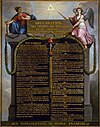Painting
The painting is a loose and gestural bust-study rather than a finished work, [1] a sketch for the 1826 full-length portrait of Lafayette that had been commissioned by the City of New York to commemorate Lafayette's role in the American Revolutionary War. [2] The sketch focused on capturing a portrait of Lafayette during his brief visits to New York City from 1824–25. The majority of the painting was done in February 1825. [3]
Morse had great respect for Lafayette, remarking "My feelings were almost too powerful for me... This is the man... who spent his youth, his fortune, and his time, to bring about (under Providence) our happy Revolution; the friend and companion of [George] Washington, terror of tyrants, the firm and consistent supporter of liberty, the man whose beloved name has rung from one end of the continent to the other, whom all flock to see, whom all delight to honor." [4]
Provenance
Once his full-length portrait was completed, Morse, having no compelling need for this sketch, gave it to Philip Hone (often called "The Honorable Philip Hone" by contemporaries), the Mayor of New York City. Morse likely gave it to Hone because he was in charge of the commission. [5]
Upon Hone's death, an "Inventory of Paintings, Statuary, Medals, etc, the Property of the Late Philip Hone, to be sold at public auction" was taken, which included this painting. [6] William H. Osborn, a railroad tycoon who was a patron of the arts and had a personal art collection, bought the painting at the April 28, 1852 auction. [7]
Osborn gave the painting to the wealthy James Lenox in 1876. Like the majority of his art collection, the painting was displayed in Lenox's newly built Lenox Library, and was listed in the 1879, 1885, and 1892 catalogues. [8] The 1879 Lenox Library Guide to the Paintings and Sculptures states that the painting was "Presented by William H. Osborn, November, 1876." [9]
A few decades later the painting was donated to the New York Public Library, where it was displayed and periodically loaned out to other museums. [10]
It sold at Sotheby's as lot 1 on November 30, 2005. The Crystal Bridges Museum bought it for US$1,360,000 (equivalent to $2,037,799in 2022). [11]

The Boston Athenaeum is one of the oldest independent libraries in the United States. It is also one of a number of membership libraries, for which patrons pay a yearly subscription fee to use Athenaeum services. The institution was founded in 1807 by the Anthology Club of Boston, Massachusetts. It is located at 10½ Beacon Street on Beacon Hill.

The Lansdowne portrait is an iconic life-size portrait of George Washington painted by Gilbert Stuart in 1796. It depicts the 64-year-old president of the United States during his final year in office. The portrait was a gift to former British Prime Minister William Petty, 1st Marquess of Lansdowne, and spent more than 170 years in England.

Crystal Bridges Museum of American Art is a museum of American art in Bentonville, Arkansas. The museum, founded by Alice Walton and designed by Moshe Safdie, officially opened on 11 November 2011. It offers free public admission.
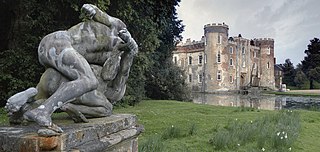
Shirburn Castle is a Grade I listed, moated castle located at the village of Shirburn, near Watlington, Oxfordshire. Originally constructed in the fourteenth century, it was renovated and remodelled in the Georgian era by Thomas Parker, the first Earl of Macclesfield who made it his family seat, and altered further in the early nineteenth century. The Earls of Macclesfield remained in residence until 2004, and the castle is still (2022) owned by the Macclesfield family company. It formerly contained an important, early eighteenth century library which, along with valuable paintings, sculptures, and other artifacts including furniture, remained in the ownership of the 9th Earl and were largely dispersed at auction following his departure from the property; notable among these items were George Stubbs's 1768 painting "Brood Mares and Foals", a record setter for the artist at auction in 2010, the Macclesfield Psalter, numerous rare and valuable books, and personal correspondence of Sir Isaac Newton.

Cortlandt Field Bishop was an American pioneer aviator, balloonist, autoist, book collector, and traveler.

George Henry Durrie was an American landscape artist noted especially for his rural winter snow scenes, which became very popular after they were reproduced as lithographic prints by Currier and Ives.
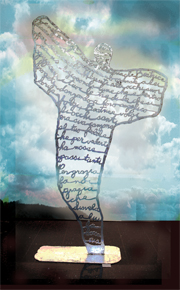
Rafael Klein also known as Randy Klein is a British American artist, living and working in London. Klein studied at the Art Students League of New York. His work includes painting, sculpture, and artists’ books. His first major exhibition was 'Tin Temples' at 112 Greene St. in New York. He moved to London in 1984, and had his studio at the Diorama alongside Justin Mortimer and Tai-Shan Schierenberg. From 1991 - 2000 he was lecturer in Metal Sculpture at City and Islington College. He has work in private and public collections in Europe and the USA, including the Tate Gallery, the Victoria and Albert Museum, and the Museum of Modern Art. He has created public sculptures including at Nunhead Station, London and the Biblioteca Classense in Ravenna], Italy.
Jonathan Lewis lives and works in New Jersey, USA. He makes photo-based art that explores themes of visual memory and modern communication via the elemental properties of the pixel and the low-fi aesthetic of the screen-grab. His subjects, ranging from candy wrappers and emojis to haute couture and works of art reflect an uncritical fascination for the artificial and the man-made. His process, often pixelating images beyond recognition, criss crosses the border between figuration and abstraction, and his work takes the form of digital prints, sculpture, video, books, and painting. He is a founding member of the ABC Artists' Books Cooperative.

The Lenox Library was a library incorporated and endowed in 1870. It was both an architectural and intellectual landmark in Gilded Age–era New York City. It was founded by bibliophile and philanthropist James Lenox, and located on Fifth Avenue between 70th and 71st Streets on the Upper East Side of Manhattan. Renowned architect Richard Morris Hunt designed the building, which was considered one of the city's most notable buildings, until its destruction in 1912.

The American Art Association was an art gallery and auction house with sales galleries, established in 1883.

Alexander Hamilton is a marble bust portrait of American Founding Father Alexander Hamilton, done in the style of a Roman Senator, by the Italian sculptor Giuseppe Ceracchi. Ceracchi also created many replicas, in both marble and plaster. The bust was later used as a model for several notable sculptures, paintings, and other works featuring Hamilton.

Expulsion from the Garden of Eden was painted in 1828 by English-born American painter Thomas Cole. It belongs to the collection of the Museum of Fine Arts, Boston and is on display in their Waleska Evans James Gallery. This landscape painting exemplifies the style of the Hudson River School, which was a group of American landscape painters that Thomas Cole is credited with founding. On the lower left part of the cliff, Cole signed his name as "T Cole".

Dismissal of School on an October Afternoon was painted by Henry Inman. An elected founding member of the National Academy of Design, Inman was well known in the New York City art scene. Although predominately known for his portrait paintings, Henry Inman was also known for painting genre scenes and literary subjects. Commissioned by James Cozzens, this painting was finished on November 8, 1845, which makes it his last completed painting before his January 1846 death. It is a culmination of his successful career, as it is a blend of landscape, genre, and literary reference.
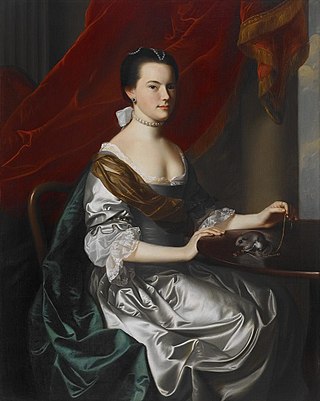
Mrs. Theodore Atkinson Jr. is an oil-on-canvas portrait painting completed in 1765 by the American artist John Singleton Copley. It is now housed in the Crystal Bridges Museum of American Art.

David Redden is a retired American auctioneer. He spent his entire career, from 1974 to 2016, with Sotheby's where he was a vice-chairman and was Sotheby's longest serving auctioneer. He has also chaired the boards of several American and British preservation and educational organizations.
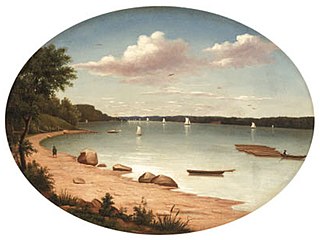
Robert G. L. Leonori was an American artist. Born in New York, he was a member of the American Art-Union and associated with the Hudson River School of landscape painters.

Noma Copley was an American fine arts jeweler and art collector noted for her contributions to Surrealist practices and activities. From 1953 through 1968, she was married to William Copley and, with him, helped to acquire one of the largest collections of Surrealist paintings and sculpture in America. In 1954, they established the William and Noma Copley Foundation, a non-profit organization dedicated to fostering the creative arts. According to a 1975 article in New York Magazine, she "emerged from the Paris world of surrealist painters five years ago to become one of New York's most original jewelry designers."


